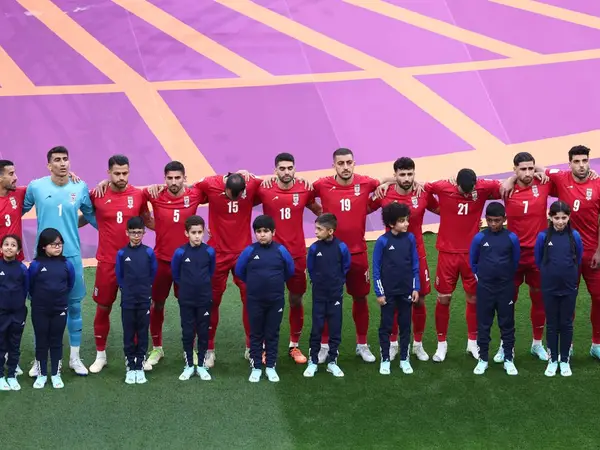Why Iran’s football (soccer) team in Qatar refused to sing the national anthem in its first game, which was their subtle gesture amid popular protests.
Every country has national symbols that represent its rich culture and history, traditions, and unique attributes of the land and its people. The national anthem is one such symbol that evokes feelings of patriotism among the citizens, binds them with a united purpose and collective identity, and reminds them of what they perceive as their nation's glorious heritage. It is nearly universal that national anthems demand reverence and are viewed by many as a sacred representation of their nation. It is common to see people rise and place a hand on their heart to show their commitment to their land and display their patriotism as they hear their anthem performed.
As Iran’s widespread protests enter their third month, there is an unusual phenomenon that is visible on the world stage. Many Iranians are distancing themselves from their national anthem. Iranian athletes competing in national and international arenas have chosen silence and adopted a posture of mourning during the opening ceremonies with the anthem playing. In none of the clips of popular unrests emerging from Iran has the anthem been featured or chanted. It may seem out of place that a movement of freedom for Iran would eschew what is supposed to be a symbol of national unity. But a review of the history of this anthem adopted in 1990 by the Islamic Republic provides clues as to why Iranians have moved away from this “national symbol.”
The current national anthem of Iran is the third anthem adopted by the Islamic Republic since the 1979 revolution. For three months after the revolution, “Ey Iran” was the anthem which was non-political and non-religious and recounted the history, beauty, resilience, and culture of Iran. Subsequently, to promote the identity of the Islamic Republic, another anthem entitled “Payandeh Bada Iran” was adopted that celebrated the achievements of the Revolution. After the end of the Iran-Iraq war in 1988 and the death of Supreme Leader Ayatollah Ruhollah Khomeini in 1989, a competition was announced for a new national anthem to raise the spirits of the war torn and mournful nation. This led to the adoption in 1990 of “Sorude Melliye Jomhuriye Eslamiye Iran” which translates as the National Anthem of the Islamic Republic of Iran.
The current anthem is short. The translation of the lyrics are as follows:
“Above the horizon rises the Eastern Sun,
The light in the eyes of the believers in truth,
The month of Bahman the pride of our faith,
Your message, O Imam [Khomeini], of independence and freedom is imprinted on our souls.
O martyrs! Your clamors echo in the ears of time:
May you endure eternally,
The Islamic Republic of Iran!”
In reviewing the lyrics, the only symbolism that celebrates the heritage of the nation is the Eastern Sun. The reference to the Sun has literary and cultural implications to the land, its calendar, and its history. But the rest of the lyrics depart from Iran’s national identity and focuses on the events and figures relating to the 1979 Revolution and its aftermath.
Since nature of the revolution was Islamic, the Sun in the first line ends up only illuminating the “eyes of believers in truth” thereby disregarding those who may believe differently than the ruling power apparatus. The month of Bahman overlaps with February, and this is a reference to the February 1st, 1979, return of the Ayatollah to Iran and the February 11th declaration of the victory of the Islamic Revolution. Why would a calendar month be represented as the pride of one’s faith? This cannot be simply faith in Islam or in the nation. This is faith in the Islamic Republic whose inception was in that fateful February (Bahman) of 1979. This further narrows the people for whom the anthem is meaningful.
In the lyrics, we come across a specific reference to Ayatollah Khomeini and a focus on his message of Independence and Freedom. Nearly 44 years have elapsed since those promises were made, and Iranians today feel that the message of the Ayatollah was only a mirage as Iran today is neither independent nor free by any stretch of the imagination.
The final part of the lyrics places words in the mouths of the fallen soldiers of the Iran-Iraq war of 1980-88. The fallen soldiers, referenced as martyrs, fought for Iran and its territorial integrity. But in a distortion of history, the lyrics suggest that their voices echo in the ears of time to eternally preserve the “Islamic Republic” rather than the nation of Iran. The sons and daughters of fallen soldiers have taken to social media to refute this notion. Additionally, the current system of government in Iran does not bear any of the hallmarks of a republic.
The sustained voices of the people of Iran are loud and clear. They want regime change. They do not wish to have a dictator as a Supreme Leader. They no longer wish to live under the Islamic Republic with its unsustainable policies within Iran and its ill-conceived engagement with the world. So, it is no surprise that an anthem that limits Iran’s definition to the confines of a particular ideology called the “Islamic Republic”, disregards its symbolism and heritage, overlooks its ancient history, and celebrates a figure with hollow promises, is mere propaganda to the Iranians rather than a symbol of national unity.
Nizam Missaghi is an Iranian-American physician. Due to being denied access to higher education under the Islamic Republic, he left Iran at 18 to pursue his education. He currently practices in the US and is also a clinical assistant professor of anesthesiology at the University of Arizona School of Medicine. He serves on the board of Iran Human Rights Documentation Center and has delivered lectures and written articles on Iran related topics.
The opinions expressed by the author are not necessarily the views of Iran International
